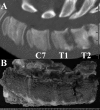Computed tomographic images of discospondylitis in a calf
- PMID: 26256229
- PMCID: PMC4710732
- DOI: 10.1292/jvms.15-0194
Computed tomographic images of discospondylitis in a calf
Abstract
A 2-month-old male Japanese Black calf was presented with a 30-day history of progressive ataxia. Antemortem examination using computed tomography (CT) revealed narrowing of the disc spaces due to destruction of intervertebral structures between the first and second thoracic vertebrae and between the second and third thoracic vertebrae. Osteolysis was evident as irregular hypoattenuating lesions within the opposing end plates of the first, second and third thoracic vertebrae. Pseudomonas aeruginosa was detected as the causative bacteria, and discospondylitis was diagnosed. To the best of our knowledge, this is the first bovine case report describing the application of CT for the diagnosis of discospondylitis.
Figures




References
-
- Betbeze C., McLaughlin R.2002. Canine diskospondylitis: Its etiology, diagnosis, and treatment. Vet. Med. 97: 673–681.
Publication types
MeSH terms
LinkOut - more resources
Full Text Sources
Other Literature Sources
Medical

